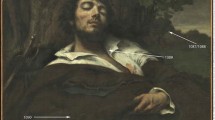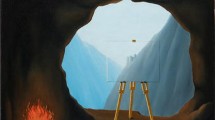Abstract
The painting L’Homme blessé by Gustave Courbet kept at the Musée d’Orsay in Paris has been recently studied by X-ray radiography, SEM–EDX observation of paint cross sections and confocal micro-X-ray fluorescence analyses (CXRF) at locations where the cross section samples were taken. This study allowed the establishment of the paint palette used by Courbet for the three paint compositions. Eight or more paint layers could be evidenced. In the view of the complexity of this painting, further analyses using two-dimensional scanning macro-X-ray fluorescence imaging (MA-XRF) providing chemical images corresponding to the superimposition of all detectable paint layers were employed. This method is combined with CXRF for depth-resolved paint layer analysis. Large elemental maps of Hg, Cu, As, Fe, Zn, Cr, Ba, Pb and Ca were obtained by MA-XRF on the painting and are discussed in combination with depth profiles obtained by CXRF on strategic points where three painting compositions overlap. The order of three successive compositions of this painting were determined in this study. This work also highlights the benefits of using complementary imaging methods to obtain a complete three-dimensional vision of the chemistry and stratigraphy of paintings.











Similar content being viewed by others
References
M. Alfeld et al., Optimization of mobile scanning macro-XRF systems for the in situ investigation of historical paintings. J. Anal. At. Spectrom. 26(5), 899–909 (2011)
J. Dik et al., Visualization of a lost painting by Vincent van Gogh using synchrotron radiation based X-ray fluorescence elemental mapping. Anal. Chem. 80(16), 6436–6442 (2008)
K. Janssens et al., Photon-based techniques for nondestructive subsurface analysis of painted cultural heritage artifacts. Acc. Chem. Res. 43(6), 814–825 (2010)
M. Radtke et al., Beyond the great wall: gold of the silk roads and the first empire of the steppes. Anal. Chem. 85(3), 1650–1656 (2013)
M. Alfeld, J.A.C. Broekaert, Mobile depth profiling and sub-surface imaging techniques for historical paintings—a review. Spectrochim. Acta Part B 88, 211–230 (2013)
M. Alfeld et al., A mobile instrument for in situ scanning macro-XRF investigation of historical paintings. J. Anal. At. Spectrom. 28(5), 760 (2013)
B. Kanngießer et al., Three-dimensionnal micro-XRF investigations of paint layers with a tabletop setup. Spectrochim. Acta Part B 60, 41–47 (2005)
B. Kanngießer, W. Malzer, I. Reiche, A new 3D micro X-ray fluorescence analysis set-up—first archaeometric applications. Nucl. Instrum. Methods Phys. Res. B 211, 259–264 (2003)
I. Reiche et al., Depth profiling reveals multiple paint layers of Louvre Renaissance paintings using non-invasive compact confocal micro-X-ray fluorescence. J. Anal. At. Spectrom. 27, 1715–1724 (2012)
I. Reiche et al., Towards a three-dimensional vision of the different compositions and the stratigraphy of the painting L’Homme blessé by Gustave Courbet: coupling SEM–EDX and confocal micro-XRF. Appl. Phys. A 121(3), 903–913 (2015)
M. Eveno et al., The Louvre Crucifix by Giotto—unveiling the original decoration by 2D-XRF, X-ray radiography. Emissiongraphy and SEM–EDX analysis. Herit. Sci. 2, 17 (2014)
E. Ravaud et al., Development of a versatile XRF scanner for the elemental imaging of paintworks. Appl. Phys. A 122, 17 (2016)
V.A. Solé et al., A multiplatform code for the analysis of energy-dispersive X-ray fluorescence spectra. Spectrochim. Acta Part B 62(1), 63–68 (2007)
L. Pichon et al., A new mapping acquisition and processing system for simultaneous PIXE–RBS analysis with external beam. Nucl. Instrum. Methods Phys. Res. B 268, 2028–2033 (2010)
S. Bergeon Langle., P. Curie, Peinture et dessin: vocabulaire typologique et technique. Ed. du Patrimoine, Centre des monuments nationaux, Paris, 2, 1249 (2009)
Acknowledgments
We thank the Musée d’Orsay and especially Isolde Pludermacher and Xavier Rey for having provided the painting for this study. X-ray radiograph was performed by Elsa Lambert and the photograph by Jean-Louis Bellec, C2RMF, Paris. We thank Dr. Michel Menu for graciously hosting E.M. in the laboratory of the C2RMF.
Author contributions
The manuscript was written through contributions of I.R., M.E., K.M. and T.C. All authors have contributed to the data acquisition. These authors contributed equally.
Author information
Authors and Affiliations
Corresponding author
Rights and permissions
About this article
Cite this article
Reiche, I., Eveno, M., Müller, K. et al. New insights into the painting stratigraphy of L’Homme blessé by Gustave Courbet combining scanning macro-XRF and confocal micro-XRF. Appl. Phys. A 122, 947 (2016). https://doi.org/10.1007/s00339-016-0457-1
Received:
Accepted:
Published:
DOI: https://doi.org/10.1007/s00339-016-0457-1




